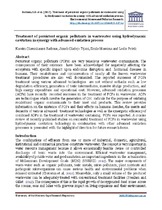Treatment of persistent organic pollutants in wastewater using hydrodynamic cavitation in synergy with advanced oxidation process
Date
2017Author
Badmus, Kassim Olasunkanmi
Tijani, Jimoh O.
Massima, Emile
Petrik, Leslie
Metadata
Show full item recordAbstract
Persistent organic pollutants (POPs) are very tenacious wastewater contaminants. The consequences of their existence have been acknowledged for negatively affecting the ecosystem with specific impact upon endocrine disruption and hormonal diseases in humans. Their recalcitrance and circumvention of nearly all the known wastewater treatment procedures are also well documented. The reported successes of POPs treatment using various advanced technologies are not without setbacks such as low degradation efficiency, generation of toxic intermediates, massive sludge production, and high energy expenditure and operational cost. However, advanced oxidation processes (AOPs) have recently recorded successes in the treatment of POPs in wastewater. AOPs are technologies which involve the generation of OH radicals for the purpose of oxidising recalcitrant organic contaminants to their inert end products. This review provides information on the existence of POPs and their effects on humans. Besides, the merits and demerits of various advanced treatment technologies as well as the synergistic efficiency of combined AOPs in the treatment of wastewater containing POPs was reported. A concise review of recently published studies on successful treatment of POPs in wastewater using hydrodynamic cavitation technology in combination with other advanced oxidation processes is presented with the highlight of direction for future research focus.

